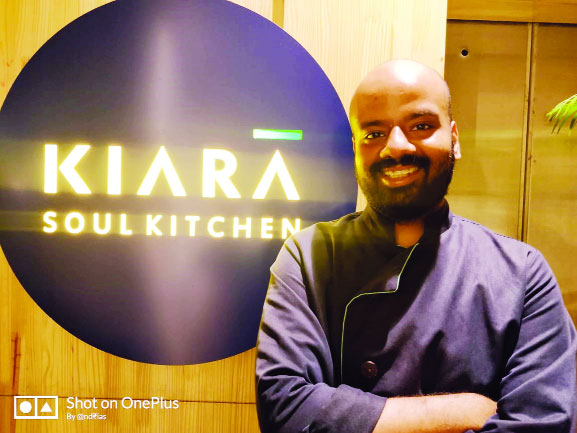Chef Siddhart Chogle shares the lessons he imbibed while working under European chefs with Chahak Mittal
For most chefs, a perfect dish comes together after hours of fusion, multiple experimentation and some failures, especially when it is inspired by the flavours from across the globe.
An avid traveller and explorer, Siddhart Chogle, Executive Chef at Kiara Soul Kitchen has been exposed to several food cultures. This has enabled the chef from Mumbai who is a culinary arts graduate from the Institute of Hotel Management (IHM), Aurangabad to develop innovative cuisines that derive inspiration from the flavours from around the world.
Siddhart started cooking at a young age and ultimately mastered the art. From working with names like The Taj and The Oberoi’s in India to kitchens like Fairmont Le Montreux Palace in Switzerland, he has explored various food and restaurant cultures.
At the restaurant, he has whipped together pan-Asian cuisine, “We do an amalgamation of flavours from all over Asia, which are then mixed up and intertwined with European-style food.”
Even though he prefers seafood, since he became a part of a vegetarian restaurant, he has cut down on non-vegetarian. “I do cook fish when I go home. I am more of a fish-eater since I am from Mumbai,” he says.
So how did he explore flavours and variants in vegetarian food especially when most people equate it with only paneer? Siddhart has an answer. “I have realised that the vegetarian cuisine has many sides and aspects that are yet to be explored. The textures are more diverse and complicated to play with in terms of cooking.” He is playing with and blending various greens to “give vegetables their rightful importance on the plate,” which over the years has got lost.
He adds, “In fact, we hardly use paneer in our dishes. We try to work with alternative sources like lentils and millets as compared to going with basic milk-based or paneer-based products.”
The chef has imbibed lessons from all over the world and shared one from Switzerland. He says, “Post my Masters, I stayed and worked in Switzerland for three years. I observed that even though the primary focus of the meal is meat, vegetables are still given a lot of importance. I think my entire philosophy of cooking vegetarian food is rooted there.”
The food space has expanded in all directions now. Today, if you take a walk at your nearby street where all the restaurants and cafes are based, one would find all the cuisine varieties — Japanese, Chinese, Thai, Indonesian, Italian, European rather than just regional Indian variations. Pan-Asian cuisine, mainly Chinese, Japanese and Thai, has become very popular in India. Siddhart says, “Earlier Asian food was represented only by Chinese. But there are a number of pan-Asian restaurants today. The popularity of pan-Asian food is because earlier it was not easily available in India.”
He added, “Social media has created awareness so now we know that a raw papaya salad needs a proper kind of dressing and stuff. Years ago, the concept was very new.”
He also highlighted how Chinese noodles are taking over staple Indian food. The first brush of Indians with noodles came with Maggi but now Chinese ‘Hakka noodles’ are used as substitutes for roti and rice by many Indians. And there are many varieties which are made with different grains and ingredients which are now easily available.
He believes that people are much more open to experimentation today and “they do not have to be related to food or be a chef or a cook nowadays to explore it. Anybody could do that. They have started going out to eat more often.”
He believes that being a chef now is a challenging job. “People have tried out so many new things and have so much more exposure. This is much more challenging than cooking for someone who is trying the dish for the first time. There could be another five versions of a Raw papaya salad or Pad Thai noddles that he would have consumed in India or in Thailand, so he knows which one suits his tastebuds perfectly. Innovation is what keeps calling back a customer.”
There are European practices, which he tries to incorporate in his culinary habits. He says, “I follow the European style of doing Mise En Place, (French word for pre-storing your food for only two days) because of which I buy them in such a way that they only last for two days. They are labelled properly and put under categories of various timings. I think India should also follow such culinary habits.”
And he does have a definite view of food being the subject of Instagram stories and feeds rather than making its way to the mouth of the person who ordered it. While chefs worldwide are debating against food bloggers, Siddhart says, “I believe that we eat food through our eyes first and this is an acknowledgment to the chef who prepared the dish that it is so appealing to his customer that he can’t take his eyes off it. Five or 10 minutes won’t make your dish stale. So why not? Thank you food bloggers (laughs).”


























